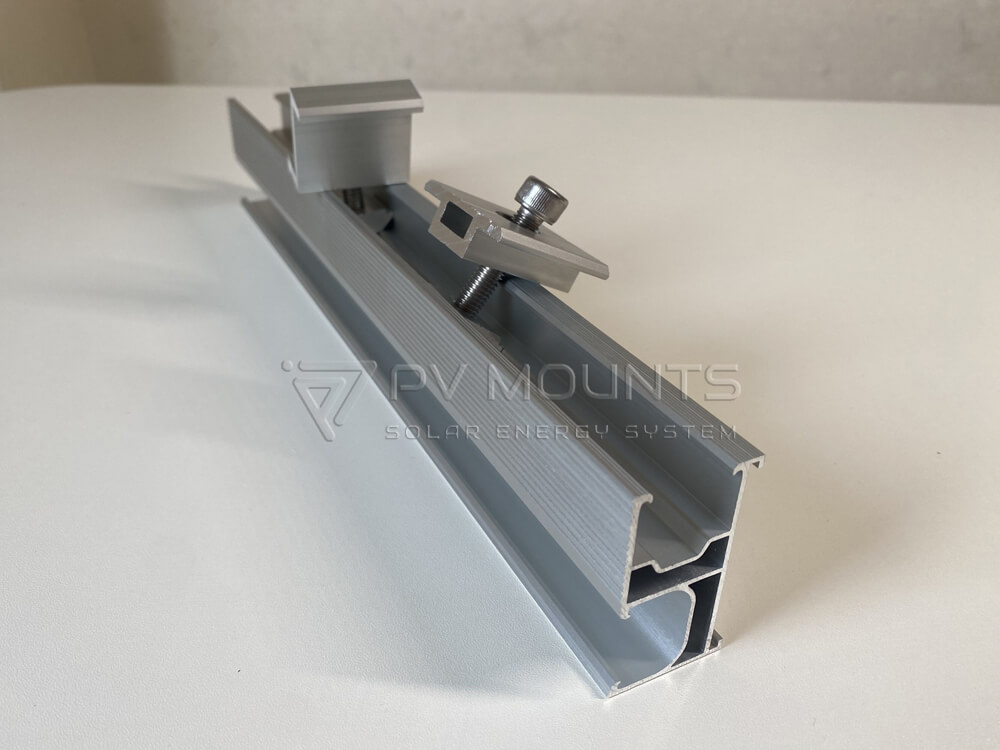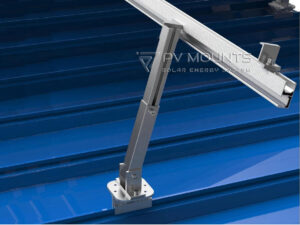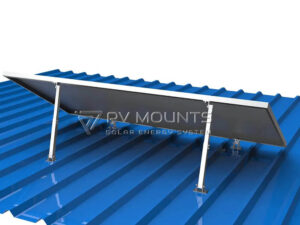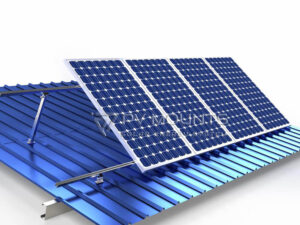Selecting the correct mounting structure for your solar panels is crucial. This choice greatly influences the system’s efficiency by determining the panels’ orientation and angle towards the sun, optimizing sunlight capture and conversion into electricity. Furthermore, a well-chosen and installed structure ensures your panels endure environmental factors, safeguarding your investment.
This artilce aims to help you through the different types of solar panel mounting structures, exploring their definitions, benefits, drawbacks, and ideal usage scenarios. By understanding the features of each type of mounting, you can make an correct decision about which is most suitable way for your requirements and circumstances, ensuring optimal performance and longevity for your solar mounting system.
Table of Contents
Roof-Mounted Structures
As the most common solar installation structure type and easiest to installed, they are installed directly on the building roof for the space usage efficiency.
There are two main types of roof mount structures: Flat and Pitched. Flat roof mounting are designed for buildings with a flat or low-slope roof, typically secured using weights or ballasts to avoid roof penetration. Pitched roof mounts are designed for sloping roofs, often secured directly to the roof’s rafters for maximum stability.
The advantages of solar roof-mounted system include space efficiency, lower installation cost, and the lack of need for additional land. They are also typically easier to connect to the existing electricity grid. However, their orientation and angle are determined by the existing roof, which might not always be optimal for sun exposure. They may also be less accessible for maintenance and could cause roof damage if not properly installed.

Roof solar mounting structures are friendly for buildings with large, strong roofs and sun-friendly orientation, including residential house and commercial building. These structures should have robust roofs, abide by local codes, and homeowner association rules permitting solar panel installations.
Ground-Mounted Structures
Grounds solar mount structures are installed on the ground instead of roof. They are typically installed on steel or aluminum structures which are secured to the earth, often used in large-scale solar lands or when roof mounting isn’t available.
There are two types: Fixed-tilt and Adjustable-tilt. Fixed-tilt structures have solar panels set at a specific angle and fixed. On the other side, adjustable-tilt systems allow for manual adjustment of the panels’ angle to optimize sunlight exposure throughout the year.
The advantage of ground-mounted structures is able to position and orient the panels for maximum sun exposure, regardless of building orientation. They are also more accessible for maintenance. Nevertheless, they require a larger area and limited land area is not recommended. Installation of ground-mounted structures may be more expensive and complex, owing to required ground preparation and potential zoning regulations.

Ground-mounted solar system are ideal for locations with ample land space. They’re also a good solution when the roof is unsuitable for solar panels due to size, shading, orientation, or structural problems. Commercial solar installations, solar farms, or residential settings with large-scale property land.
Pole-Mounted Structures
Pole-mounted solar structures are mounted on singular poles, often used in settings where space is at a premium or the ground and roof are unsuitable for mounting. These structures may be stationary or equipped with a tracking system to follow the sun’s path.
The advantage of Pole-mounted is flexible positioning, enabling solar panel installation in a variety of locations. They also offer easy access for maintenance and the potential for tracking the sun. Anyway, they handle fewer panels per pole, and the installation process may be more complicated and expensive because of the need for a firm and stable pole structure.
Pole-mounted structures are best suited for locations where ground and roof installations are unfeasible, due to constraints like limited space, poor roof conditions, or regulatory limits. They’re particularly effective in off-grid settings requiring maximum solar efficiency through sun tracking.
Tracking-Mounted Solar Structures
Tracking mounts system are complex and move to follow the sunlight path throughout the day. By aligning the panels directly with the sunlight, tracking mounted structure significantly enhance the energy output of solar panels, ensuring maximum solar exposure.
Two types of Tracking mounted structures are widely used: Single-axis and Dual-axis. Single-axis tracking system move from east to west, following the sun’s daily path. Dual-axis trackers, in addition to the east-west movement, also adjust for the sun’s changing elevation in the sky throughout the year, providing the maximum possible solar energy collection.
The primary advantage of tracking structure is their increased energy production, as they maximize the amount of sunlight the panels receive. However, they are typically more costly and complicated to install and maintain than other types. More space is required to avoid shading adjacent panels as they move.
Tracking mounts are best solution for spacious, sun-rich areas, commonly in utility-scale solar setups, space-unrestricted residential or commercial locations aiming for maximum energy, and off-grid installations requiring optimal power generation.
Building-Integrated Photovoltaics (BIPV)
Building-Integrated Photovoltaics (BIPV) are solar panels or materials integrated into a building’s construction rather than added afterwards. This can include photovoltaic materials incorporated into windows, roof tiles, facades, and more, turning the building itself into a power generator.
BIPV have the advantage of pleasing design, space efficiency, and multifunction as both a building material and energy generator. BIPV can also offset construction costs by substituting for conventional building materials. Yet, they can be more expensive to install and replace, and their orientation is fixed based on the building’s design, which may not be optimal for sunlight exposure.
BIPV is ideal for new constructions or major renovations where the building design can accommodate and optimize these systems. This includes both residential and commercial buildings. BIPV is particularly available in urban areas where space is at a premium and traditional solar installations might not be feasible.
Floating Solar Mounts
Floating solar mounts, also known as floatovoltaics, are solar panels mounted on pontoons and floated on bodies of water like reservoirs, ponds, or lakes. This increasingly popular type of solar installation allows the beneficial use of water surfaces for solar power generation.
Floating solar mounts utilize unoccupied water surfaces, prevent land usage, and can reduce evaporation and control algae. The water’s cooling effect boosts panel efficiency. However, their installation and upkeep may be more challenging than land systems, and they aren’t fit for turbulent waters or areas with heavy boat traffic.
Floating solar mounts are perfect for areas with substantial calm waters, including reservoirs and lakes. They’re excellent for land-scarce or densely populated regions seeking to boost solar capacity without land usage. Industries with large bodies of water, like wastewater facilities or farms with irrigation ponds, also benefit.
Carport Solar Mounting
Carport Solar mounting are installed atop carports – structures designed to cover parked vehicles. These systems offer dual purposes by providing shade and protection for vehicles while also converting sunlight to electricity.
Carport mounting serve as both vehicle protectors and power generators, effectively using parking space and enhancing aesthetics. However, they often cost more than roof mounts due to standalone structure needs. Also, their solar exposure depends on the carport layout, which means no maximum solar generation.
Carport solar mounts system are best suitable for homes, businesses, or institutions with large parking areas that receive ample sunlight. They are particularly valuable in hot climates where shade for vehicles is beneficial. Carport mounts also serve well in places where roof or ground installations aren’t feasible or desirable.

Balcony Solar Mounting
Balcony solar mounts are small-scale solar installations designed to be placed on the balconies of buildings. They provide an opportunity for solar power generation in urban or high-rise living situations where traditional solar installations may not be feasible.
Balcony solar mounts come to the advantage of bringing solar power to urban residents who may not have other options. They are typically easier and cheaper to install than traditional solar mounting system. However, their power generation capacity is significantly less due to their smaller size, and their effectiveness depends heavily on the balcony’s orientation and unobstructed access to sunlight.
Balcony solar mounts are a good option for high-rise or urban dwellers who want to benefit from solar energy but don’t have access to a roof or ground space for a traditional solar installation. They are also suitable for individuals in rented properties where installing a full-scale solar system may not be permissible.

In conclusion
In a word, each type of solar panel mounting structures has its unique advantages, drawbacks, and ideal use cases, from large-scale utility installations to individual urban dwellers seeking to generate solar energy.
Choosing the right solar mounting structure, as crucial as picking the panels themselves, must align with your unique needs, conditions, and goals. Factors like location, space, climate, and regulations are key. The correct choice optimizes efficiency, durability, and solar investment returns.













